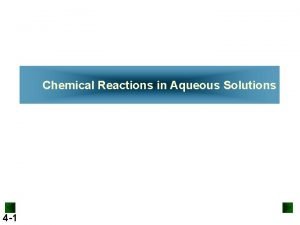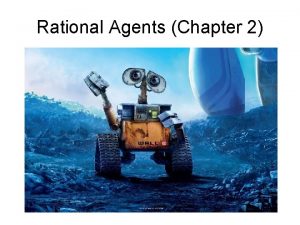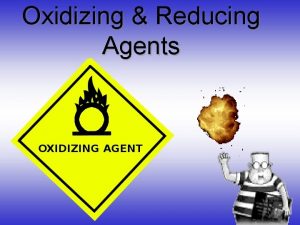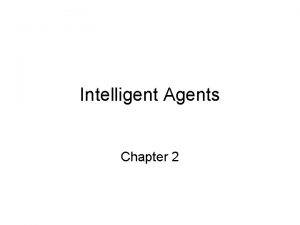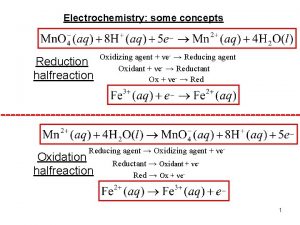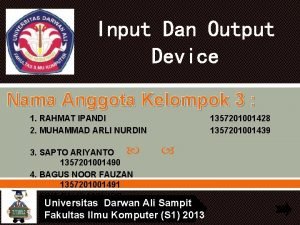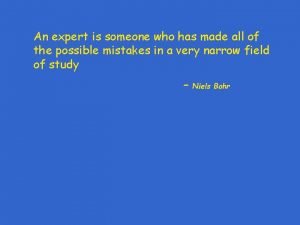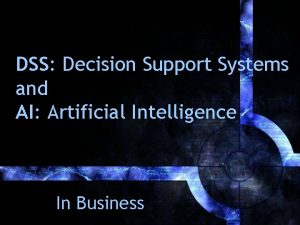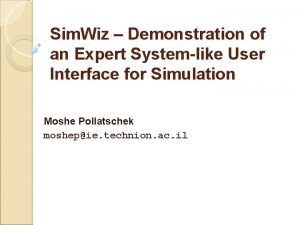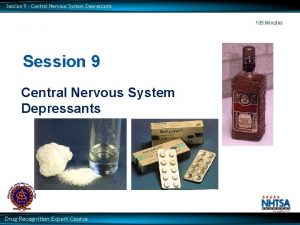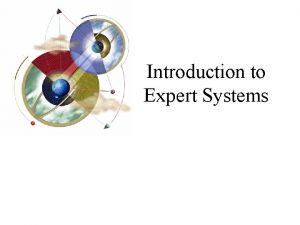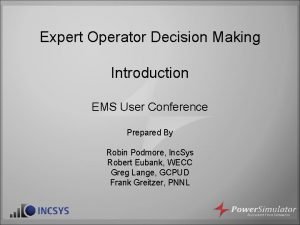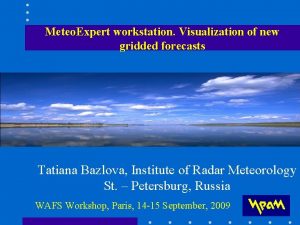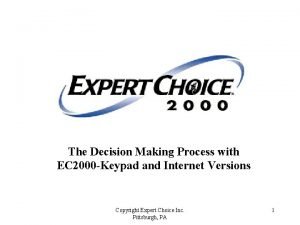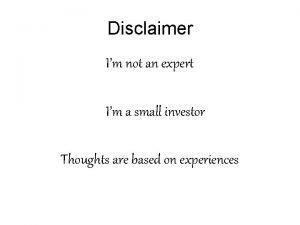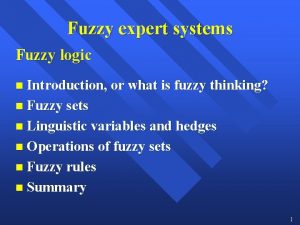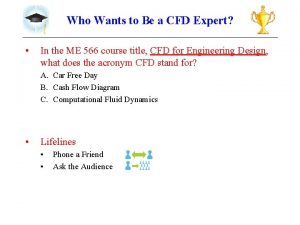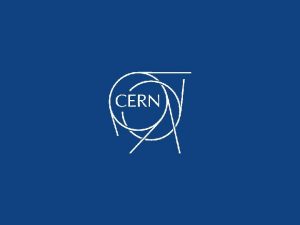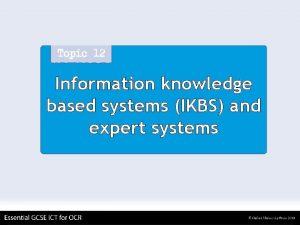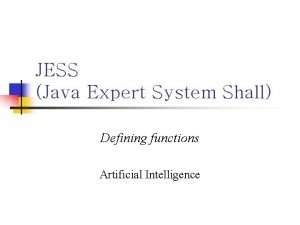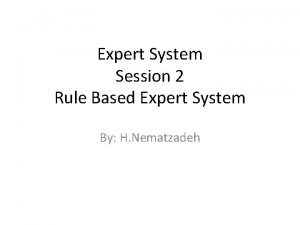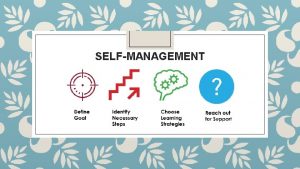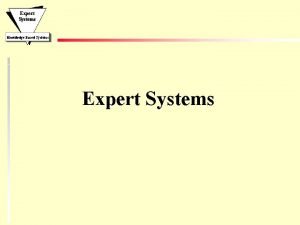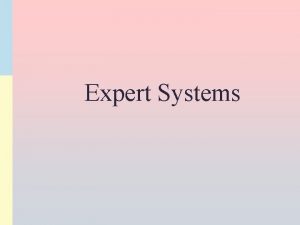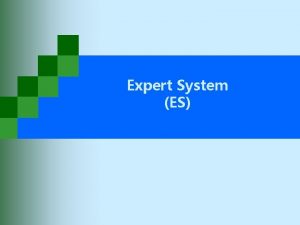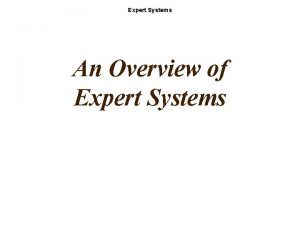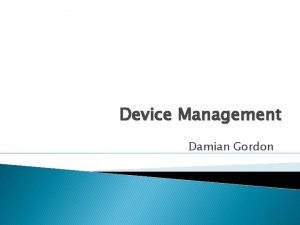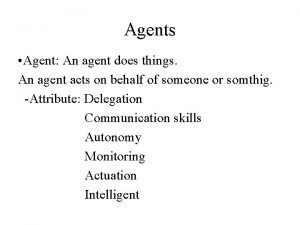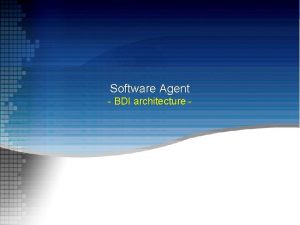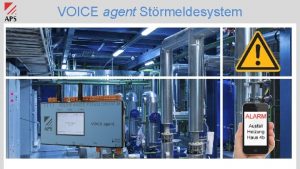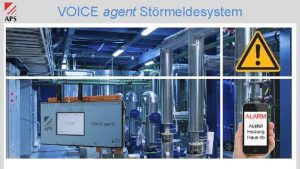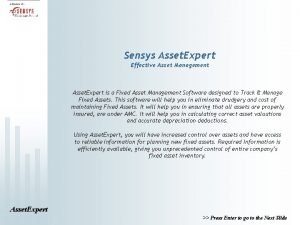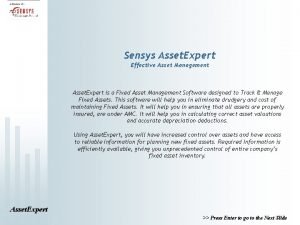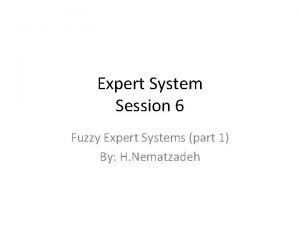AgentDriven SelfManagement Resource Agent Device Resource Agent Expert



































- Slides: 35

Agent-Driven Self-Management Resource Agent “Device” Resource Agent “Expert” Resource Agent “Service”

IBM: Autonomic Computing (1) § The computing domain is now a vast and diverse matrix of complex software, hardware and services. By 2020 we expect billions of devices and trillions of software processes, with a lot of data. And it's not just a matter of numbers. It's the complexity of these systems and the way they work together that is creating a shortage of skilled IT workers to manage all of the systems. It's a problem that's not going away, but will grow exponentially, just as our dependence on technology has. § Autonomic Computing is about how to enable computing systems to operate in a fully autonomous manner. No administration, just simple high-level policy statements. § Autonomic Computing is an approach to self-managed computing systems with a minimum of human interference. The term derives from the body's autonomic nervous system, which controls key functions without conscious awareness or involvement.

IBM: Autonomic Computing (2)

“Self-(re)configuration” example 107 kg • Professor in Software Engineering; • Head of Artificial Intelligence Dep. ; • Head of “Meta. Intelligence” Research Lab. • … in Kharkov National University of Radioelectronics (Ukraine) “Self-reconfigurable“ means that the system is capable of utilizing its own system of control to change its overall structural shape. 82 kg • Professor in Distributed Systems; • Head of Industrial Ontologies Group … • … in the Department of Mathematical Information Technology, University of Jyvaskyla (Finland)

Self-Configurable Systems: Invented by Hollywood?

Why self (re)configuration? Versatility: Self-reconfigurable systems are potentially more adaptive than conventional systems. The ability to reconfigure allows a system to disassemble and reassemble components to form new morphologies that are better suited for new tasks, One source of inspiration for the development of these systems comes from biological systems that self-construct out of a relatively small repertoire of lowerlevel building blocks (cells or amino acids, depending on the scale of interest). This architecture underlies the ability of biological systems to physically adapt, grow, heal, and even self-replicate capabilities that would be desirable in many engineered systems. Robustness: Since system components are interchangeable (within a system and between different systems), self-reconfigurable systems can also replace faulty parts autonomously, leading to self-repair. Low Cost: Self-reconfigurable systems can potentially lower overall cost by making many copies of one (or relatively few) type of modules so economies of scale and mass production come into play. Also, a range of a system can be made from one set of modules, saving costs through reuse and generality of the system.

Dynamic reconfigurability vs. self-configurability • Dynamic reconfigurability is reconfigurability at runtime, but not necessarily based on system self-awareness and intentions and not necessarily supported by any special algorithms. • Self-configurability is going one step beyond – the system is expected to autonomously and deliberately perform the reconfiguration.

What is configuration? • Composition (content: components of data and capabilities), • Structure (partonomy, business logic and interaction applied to content) • and Parameters (features of the content and structure)

What is configuration of a self-configurable system? E n v i r o n m e n t (“Policies”) Utility function (“Mind”) Composition and Structure (“Body”) Data and Knowledge (“Beliefs”) Parameters (“Features”) System Engine (“Soul”) Capabilities (“Skills”) Everything is configurable !

What is an Intelligent Agent? Self-Configurability ! Events ENVIRONMENT Self-Awareness Self-Configuration Behavior

Agent and the World (W = Internal + External Environments) “Behavior” function Agenti Where fi is individual behavior fi ωi “Read Only” world Agenti alone may “play” a function: φi = fi (ωi), φi “Read and Write” world “Write Only” world

Indirect Collaboration (via communication) Communication fi ωi φi fk ωk φk Agenti and Agentk together may “play” 6 types of functions: φi = fi (ωi); φk = fk (ωk); φi = fki (ωk); φk = fik (ωi); φi = F 1 (f ( i (ωi), fki (ωk)); φk = F 2 (f ( k (ωk), fik (ωi)), where F - collaborative behavior Need ontological mapping between Ont(Agenti) and Ont(Agentk)

Indirect Control (via environment) Environmental Rules ωi φi ωj φj Agenti may “play” 2 types of functions knowing rules of the environment: φi = f (ωi); φj = R (f (ωi)), where R – function of environmental rules

Summary: Why Agents ? • Growing complexity of computer systems and networks • Distributed nature of systems (data, software, users, etc. ) • Ubiquitous computing, “Internet of Things” scalability challenges • Need for self-manageability of a complex system • Need for new software development paradigms in designing distributed systems • Agent-based approach meets the above challenges … • And finally: Agents are excellent tool for self-configuration !!!

Web of Configurations … is the Web of “partonomy” (a classification based on part-of relation; not the same as taxonomy, which is a classification based on similarities). Configuration of an object (parts and their relationships) together with all policies applied to these parts fully describes the object from inside. is. Part. Of Facilitates Configuration-to -Configuration interaction

Proactive Configuration Part_of product hierarchy in the ontology results to hierarchical MAS is. Part. Of

Configuration of objects vs processes 1 1. 1. 1 1. 2 1. 1. 3 1. 2. 1 1. 2. 3 1. 2. 2 1 1. 1. 1. 2 1. 1. 3 1. 2. 1 1. 2. 2 1. 2. 3 Axiom 1: Each resource in dynamic Industrial World is a process and each process in this world is a resource. Axiom 2: Hierarchy of subordination among resource agents in GUN corresponds to the “part-of” hierarchy of the Industrial World resources.

Resource Configuration Example has. Configuration (ID 1, ID 2) Locomotive (ID 3) has. Color (ID 3, “Muticolor”) has. Behind (ID 3, ID 4) Car (ID 4) Train (ID 1) has. Color (ID 4, “Beige”) has. Part (ID 1, ID 3) has. Behind (ID 4, ID 5) has. Part (ID 1, ID 4) has. Ahead (ID 4, ID 3) has. Part (ID 1, ID 5) has. Destination. To (ID 1, “Paris”) has. Destination. From (ID 1, “Amsterdam”) has. Configuration (ID 3, ID 6) has. Configuration (ID 4, ID 7) has. Configuratioin (ID 5, ID 8) Car (ID 5) has. Color (ID 5, “Red”) has. Ahead (ID 5, ID 4)

Configuration Components Object of configuration Content of configuration has. Configuration (ID 1, ID 2) Train (ID 1) has. Part (ID 1, ID 3) has. Part (ID 1, ID 4) has. Part (ID 1, ID 5) has. Destination. To (ID 1, “Paris”) has. Destination. From (ID 1, “Amsterdam”) Class of the resource Structure of the resource Parameters’ values of the resource has. Configuration (ID 3, ID 6) has. Configuration (ID 4, ID 7) has. Configuratioin (ID 5, ID 8) Configuration of structural components

Reconfiguration has. Configuration (ID 1, ID 2) has. Configuration (ID 1, ID 8) Train (ID 1) has. Part (ID 1, ID 3) has. Part (ID 1, ID 4) has. Part (ID 1, ID 5) has. Destination. To (ID 1, “Paris”) has. Destination. From (ID 1, “Amsterdam”) has. Configuration (ID 3, ID 6) has. Configuration (ID 3, ID 9) has. Configuration (ID 4, ID 7) has. Configuration (ID 4, ID 10) has. Configuratioin (ID 5, ID 8) has. Configuratioin (ID 5, ID 11)

Reconfiguration behavior (option 1: reordering) has. Configuration (ID 1, ID 8) Locomotive (ID 3) has. Color (ID 3, “Muticolor”) Train (ID 1) has. Behind (ID 3, ID 5) has. Part (ID 1, ID 3) has. Part (ID 1, ID 4) has. Part (ID 1, ID 5) has. Destination. To (ID 1, “Paris”) has. Destination. From (ID 1, “Amsterdam”) Car (ID 4) has. Color (ID 4, “Beige”) has. Ahead (ID 4, ID 5) Car (ID 5) has. Configuration (ID 3, ID 9) has. Color (ID 5, “Red”) has. Configuration (ID 4, ID 10) has. Ahead (ID 5, ID 3) has. Configuratioin (ID 5, ID 11) has. Behind (ID 5, ID 4)

Reconfiguration behavior (option 2: recolor) has. Configuration (ID 1, ID 12) Locomotive (ID 3) has. Color (ID 3, “Muticolor”) Train (ID 1) has. Part (ID 1, ID 3) has. Part (ID 1, ID 4) has. Part (ID 1, ID 5) has. Destination. To (ID 1, “Paris”) has. Destination. From (ID 1, “Amsterdam”) has. Behind (ID 3, ID 4) Car (ID 4) has. Color (ID 4, “Red”) has. Ahead (ID 4, ID 3) has. Behind (ID 4, ID 5) has. Configuration (ID 3, ID 6) Car (ID 5) has. Configuration (ID 4, ID 13) has. Color (ID 5, “Beige”) has. Configuratioin (ID 5, ID 14) has. Ahead (ID 5, ID 4)

External World EK&C Components Users and Admins UBIWARE Abstract Architecture Applications Internal Knowledge and Capabilities (IK&C) IK&C Components Engine External Knowledge and Capabilities (EK&C) Ontology Interfaces (GUI) UBIWARE

Current UBIWARE Agent Architecture S-APL – Semantic Agent Programming Language (RDF-based) S-APL – is a hybrid of semantics (metadata / ontologies/ rules) specification languages, semantic reasoners, and agent programming languages. It integrates the semantic description of domain resources with the semantic prescription of the agents' behaviors S-APL: http: //www. cs. jyu. fi/ai/Onto. Group/ubidoc/

UBIWARE 3. 0 (2009 -2010) platform (August 2010) UBIWARE 3. 0 is a platform for creating and executing configurable distributed systems based on generalized and reusable business scenarios, which heterogeneous components (actors) are not predefined but can be selected, replaced and configured in runtime.

Key Components of UBIWARE Scientific Impact 3. Language 2. Engine 4. Ontonuts 1. UBIWARE: Approach and Architecture

Ubi. Dubi: UBIWARE-driven-UBIWARE (i. e. UBIWARE architectural components are also agent-driven) Soft. Soul Genome is part of semantically marked-up agent configuration settings, which can serve as a tool for agent evolution: inheritance crossover and mutation “Visible” to other agents through observation RBE Soft. Mind Hard. Mind Beliefs RAB (facts, rules, policies, plans, collaboration protocols) RAB Shared RABs RBE Shared Beliefs Shared RBEs RAB contained, self-described, semantically marked-up proactive agent capability (agent-driven ontonut), which can be “seen”, discovered, exchanged, composed and “executed” (internally or remotely) across the agent platform in a task-driven way and which can perform social utility-based behavior RBE Ontobility is self- Meta-Beliefs Hard. Soul Meta-Beliefs (contexts) Shared RAB Reusable Behavior Engine (GENOME) Reusable Atomic Behavior RBE – Configuration RAB – “Life” Behavior Soft. Body Hard. Body Shared Hardware Environment May be an agent

Consequence of Self-Management: "Everything-as-a-User"

"Everything-as-a-User" • Brief Summary: My view to the future of doing internet-assisted business is based on the assumption that quite soon we (humans) will not be the only ones who will use (decide why and what, order and pay for) the services provided through the Web. The ongoing trend on bridging heterogeneous Webs (Web of Humans, Web of Services, Web of Things, Web of Knowledge, etc. ) has resulted to the following well-known slogan: Eaa. S - "Everything-as-a-Service". However, why not to say wider: Eaa. S 4 E - "Everything-as-a-Service-for-Everything", which also implies: Eaa. U - "Everything-as-a-User"? I suggest to discuss this. It is really difficult to imagine, how many different and interesting challenges should be addressed to make this vision happen! I will try to point out some of them. To make the discussion more concrete, I would suggest to consider 3 groups of services (before - traditionally human-centric): 1. Education for Everything; 2. Wellness and Healthcare for Everything; 3. Financial Services for Everything. Lets imagine that actual service consumer is a device or machine, software component or software system, mathematical abstraction, knowledge or intelligence, . . . and try to discuss and figure out together, why and how all of these may proactively discover and utilize various services through the Web. And finally the most interesting one: how we (humans) will benefit out of it?

Services as well as products can be consumed not only by humans

Educational Services for Everything? Machine Learning?

Wellness and Healthcare Services for Everything ? Maintenance

Financial Services for Everything ?

Urban Services for Everything ?

Have we realized already? • We are not only users of the agents any more. . . We are “Service-Providers” as well • Are we ready for that?
 Cpu output device
Cpu output device Reducing agent vs oxidizing agent
Reducing agent vs oxidizing agent Agent function vs agent program
Agent function vs agent program Reductant in chemistry
Reductant in chemistry Part picking robot peas
Part picking robot peas Table of standard electrode potential
Table of standard electrode potential A tagout device is preferable to using a lockout device.
A tagout device is preferable to using a lockout device. Input device dan output device
Input device dan output device Resource allocation vs resource leveling
Resource allocation vs resource leveling Perbedaan antara resource loading dan resource levelling
Perbedaan antara resource loading dan resource levelling An expert is someone who
An expert is someone who Sgt. john kenneth ferrier
Sgt. john kenneth ferrier Difference between dss and expert system
Difference between dss and expert system Media person example
Media person example Wiz expert
Wiz expert Rig expert aa-30
Rig expert aa-30 Tranquilizers examples
Tranquilizers examples Th expert
Th expert Asley acne expert
Asley acne expert Whats an expert system
Whats an expert system Expert operator system
Expert operator system Meteo expert
Meteo expert Expert choice 2000
Expert choice 2000 Jane ireland psychologist
Jane ireland psychologist Disclaimer i am not an expert
Disclaimer i am not an expert Fuzzy expert systems
Fuzzy expert systems Introduction to artificial intelligence and expert systems
Introduction to artificial intelligence and expert systems Cfd expert
Cfd expert Efm
Efm Ikbs
Ikbs Jess expert system
Jess expert system Rule-based expert system
Rule-based expert system Patricia benner's novice to expert theory
Patricia benner's novice to expert theory Tax expert international ag
Tax expert international ag Expert sinta
Expert sinta Power scada expert
Power scada expert

